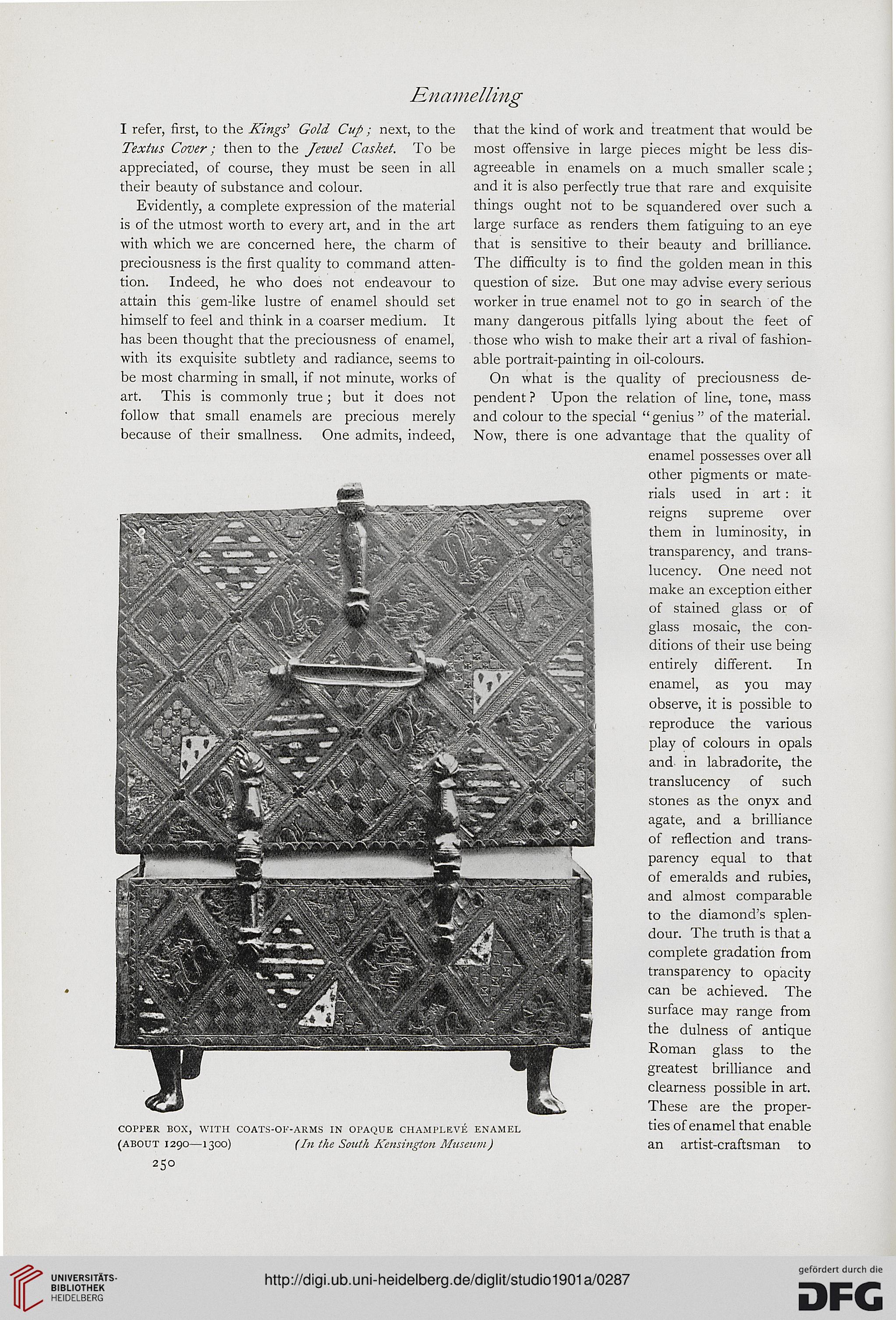Enamelling
S&r:-w 'wr/l
I refer, first, to the -Kings' Gold Cup ; next, to the that the kind of work and treatment that would be
Textus Cover; then to the Jewel Casket. To be most offensive in large pieces might be less dis-
appreciated, of course, they must be seen in all agreeable in enamels on a much smaller scale;
their beauty of substance and colour. and it is also perfectly true that rare and exquisite
Evidently, a complete expression of the material things ought not to be squandered over such a
is of the utmost worth to every art, and in the art large surface as renders them fatiguing to an eye
with which we are concerned here, the charm of that is sensitive to their beauty and brilliance,
preciousness is the first quality to command atten- The difficulty is to find the golden mean in this
tion. Indeed, he who does not endeavour to question of size. But one may advise every serious
attain this gem-like lustre of enamel should set worker in true enamel not to go in search of the
himself to feel and think in a coarser medium. It many dangerous pitfalls lying about the feet of
has been thought that the preciousness of enamel, those who wish to make their art a rival of fashion-
with its exquisite subtlety and radiance, seems to able portrait-painting in oil-colours,
be most charming in small, if not minute, works of On what is the quality of preciousness de-
art. This is commonly true; but it does not pendent ? Upon the relation of line, tone, mass
follow that small enamels are precious merely and colour to the special " genius " of the material,
because of their smallness. One admits, indeed, Now, there is one advantage that the quality of
enamel possesses over all
other pigments or mate-
|M> rials used in art : it
reigns supreme over
them in luminosity, in
transparency, and trans-
lucency. One need not
make an exception either
of stained glass or of
glass mosaic, the con-
ditions of their use being
entirely different. In
enamel, as you may
observe, it is possible to
reproduce the various
play of colours in opals
and in labradorite, the
translucency of such
stones as the onyx and
agate, and a brilliance
of reflection and trans-
parency equal to that
of emeralds and rubies,
and almost comparable
to the diamond's splen-
dour. The truth is that a
complete gradation from
transparency to opacity
can be achieved. The
surface may range from
the dulness of antique
Roman glass to the
greatest brilliance and
clearness possible in art.
These are the proper-
cori>er box, with coats-of-arms in opaque champleve enamel ties of enamel that enable
(about 1290—1300) (In the South Kensington Museum) an artist-craftsman to
250
1- f-"^-
S&r:-w 'wr/l
I refer, first, to the -Kings' Gold Cup ; next, to the that the kind of work and treatment that would be
Textus Cover; then to the Jewel Casket. To be most offensive in large pieces might be less dis-
appreciated, of course, they must be seen in all agreeable in enamels on a much smaller scale;
their beauty of substance and colour. and it is also perfectly true that rare and exquisite
Evidently, a complete expression of the material things ought not to be squandered over such a
is of the utmost worth to every art, and in the art large surface as renders them fatiguing to an eye
with which we are concerned here, the charm of that is sensitive to their beauty and brilliance,
preciousness is the first quality to command atten- The difficulty is to find the golden mean in this
tion. Indeed, he who does not endeavour to question of size. But one may advise every serious
attain this gem-like lustre of enamel should set worker in true enamel not to go in search of the
himself to feel and think in a coarser medium. It many dangerous pitfalls lying about the feet of
has been thought that the preciousness of enamel, those who wish to make their art a rival of fashion-
with its exquisite subtlety and radiance, seems to able portrait-painting in oil-colours,
be most charming in small, if not minute, works of On what is the quality of preciousness de-
art. This is commonly true; but it does not pendent ? Upon the relation of line, tone, mass
follow that small enamels are precious merely and colour to the special " genius " of the material,
because of their smallness. One admits, indeed, Now, there is one advantage that the quality of
enamel possesses over all
other pigments or mate-
|M> rials used in art : it
reigns supreme over
them in luminosity, in
transparency, and trans-
lucency. One need not
make an exception either
of stained glass or of
glass mosaic, the con-
ditions of their use being
entirely different. In
enamel, as you may
observe, it is possible to
reproduce the various
play of colours in opals
and in labradorite, the
translucency of such
stones as the onyx and
agate, and a brilliance
of reflection and trans-
parency equal to that
of emeralds and rubies,
and almost comparable
to the diamond's splen-
dour. The truth is that a
complete gradation from
transparency to opacity
can be achieved. The
surface may range from
the dulness of antique
Roman glass to the
greatest brilliance and
clearness possible in art.
These are the proper-
cori>er box, with coats-of-arms in opaque champleve enamel ties of enamel that enable
(about 1290—1300) (In the South Kensington Museum) an artist-craftsman to
250
1- f-"^-




